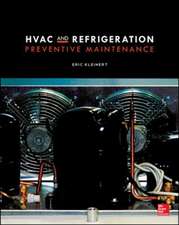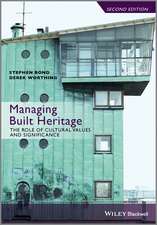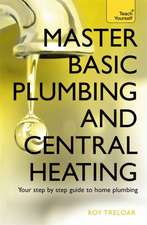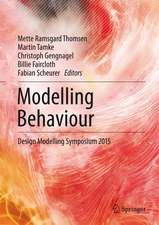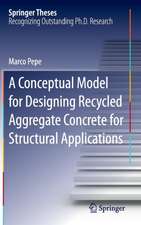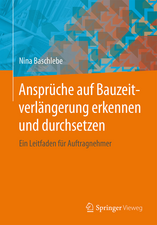Calcined Clays for Sustainable Concrete: Proceedings of the 1st International Conference on Calcined Clays for Sustainable Concrete: RILEM Bookseries, cartea 10
Editat de Karen Scrivener, Aurélie Favieren Limba Engleză Hardback – 18 mai 2015
Topics addressed in this book include the influence of processing on reactivity of calcined clays, influence of clay mineralogy on reactivity, geology of clay deposits, Portland-calcined clay systems, hydration, durability, performance, Portland-calcined clay-limestone systems, hydration, durability, performance, calcined clay-alkali systems, life cycle analysis, economics and environmental impact of use of calcined clays in cement and concrete and field applications.
This book compiles the different contributions of the 1st International Conference on Calcined Clays for Sustainable Concrete, which took place in Lausanne, Switzerland, June, 23-25, 2015.The papers present the latest research in their field. It contains nearly 80 papers and abstracts.
Overall, this work gives a broad view of research on calcined clays in the field of construction and will stimulate further research into calcined clays for sustainable concrete.
| Toate formatele și edițiile | Preț | Express |
|---|---|---|
| Paperback (1) | 1212.33 lei 38-44 zile | |
| SPRINGER NETHERLANDS – 23 oct 2016 | 1212.33 lei 38-44 zile | |
| Hardback (1) | 1401.61 lei 6-8 săpt. | |
| SPRINGER NETHERLANDS – 18 mai 2015 | 1401.61 lei 6-8 săpt. |
Din seria RILEM Bookseries
- 18%
 Preț: 952.09 lei
Preț: 952.09 lei - 24%
 Preț: 1946.95 lei
Preț: 1946.95 lei - 18%
 Preț: 1872.30 lei
Preț: 1872.30 lei - 18%
 Preț: 1401.16 lei
Preț: 1401.16 lei - 18%
 Preț: 2154.04 lei
Preț: 2154.04 lei - 18%
 Preț: 1824.32 lei
Preț: 1824.32 lei - 24%
 Preț: 1125.16 lei
Preț: 1125.16 lei - 20%
 Preț: 573.08 lei
Preț: 573.08 lei - 18%
 Preț: 1246.95 lei
Preț: 1246.95 lei - 24%
 Preț: 797.69 lei
Preț: 797.69 lei - 18%
 Preț: 1247.88 lei
Preț: 1247.88 lei - 18%
 Preț: 1561.68 lei
Preț: 1561.68 lei - 24%
 Preț: 788.50 lei
Preț: 788.50 lei - 24%
 Preț: 3265.93 lei
Preț: 3265.93 lei - 18%
 Preț: 1234.62 lei
Preț: 1234.62 lei - 18%
 Preț: 952.89 lei
Preț: 952.89 lei - 18%
 Preț: 939.46 lei
Preț: 939.46 lei - 18%
 Preț: 953.20 lei
Preț: 953.20 lei - 18%
 Preț: 1235.57 lei
Preț: 1235.57 lei - 18%
 Preț: 943.88 lei
Preț: 943.88 lei - 18%
 Preț: 1244.89 lei
Preț: 1244.89 lei - 18%
 Preț: 939.94 lei
Preț: 939.94 lei - 18%
 Preț: 1231.78 lei
Preț: 1231.78 lei - 18%
 Preț: 938.66 lei
Preț: 938.66 lei - 18%
 Preț: 2511.88 lei
Preț: 2511.88 lei - 18%
 Preț: 1222.94 lei
Preț: 1222.94 lei - 18%
 Preț: 947.85 lei
Preț: 947.85 lei - 18%
 Preț: 956.72 lei
Preț: 956.72 lei
Preț: 1401.61 lei
Preț vechi: 1709.28 lei
-18% Nou
Puncte Express: 2102
Preț estimativ în valută:
268.19€ • 281.02$ • 221.71£
268.19€ • 281.02$ • 221.71£
Carte tipărită la comandă
Livrare economică 12-26 aprilie
Preluare comenzi: 021 569.72.76
Specificații
ISBN-13: 9789401799386
ISBN-10: 9401799385
Pagini: 500
Ilustrații: XVI, 597 p. 268 illus., 141 illus. in color.
Dimensiuni: 155 x 235 x 30 mm
Greutate: 1.03 kg
Ediția:2015
Editura: SPRINGER NETHERLANDS
Colecția Springer
Seria RILEM Bookseries
Locul publicării:Dordrecht, Netherlands
ISBN-10: 9401799385
Pagini: 500
Ilustrații: XVI, 597 p. 268 illus., 141 illus. in color.
Dimensiuni: 155 x 235 x 30 mm
Greutate: 1.03 kg
Ediția:2015
Editura: SPRINGER NETHERLANDS
Colecția Springer
Seria RILEM Bookseries
Locul publicării:Dordrecht, Netherlands
Public țintă
ResearchCuprins
PART I.- Sulphate and ASR resistance of concrete made with calcined clay blended cements.- The influence of metakaolin on limestone reactivity in cementitious materials.- Sustainable secondary resources from Brazilian kaolin deposits for the production of calcined clays.- Carbonation of blended binders containing metakaolin.- Service Life and Environmental Impact due to Repairs by Metakaolin Concrete after Chloride Attack.- Properties of Calcined Lias Delta clay - technological effects, physical characteristics and reactivity in cement.- Alternative binders based on lime and calcined clay.- Optimization of cements with calcined clays as supplementary cementitious materials.- Feasibility of Calcined Marl as an Alternative Pozzolanic Material.- From ancient to modern sustainable concrete.- Pozzolanicity of calcined clay.- Research on properties of MK -CFBCA mineral admixtures.- Optimization of alkali activated Portland cement – calcined clay blends based on phase assemblage in the Na2O – CaO – Al2O3 – SiO2 – H2O system.- Phase assemblages in hydrated Portland cement, calcined clay and limestone blends from solid-state 27Al and 29SI MAS NMR, XRD, and thermodynamic modeling.- Heated Montmorillonite: Structure, Reactivity, and Dissolution.- Reactivity of heated kaolinite from a combination of solid state NMR and chemical methods.- Durability of Portland cement blends including calcined clay and limestone: interactions with sulfate, chloride and carbonate ions.- Thermodynamic Modeling of Portland Cement – Metakaolin – Limestone Blends.- The impact of VMA on the rheology, thixotropy and robustness of self-compacting mortars.- Calcined Coal Gangue and Clay Shale for Cementitious Materials without Clinker.- Red ceramic wastes: A calcined clay pozzolan.- Assessment of sustainability of low carbon cement in Cuba. Cement pilot production and prospective case.- Ternary blended cement with limestone filler and kaolinitic calcined clay.- Blended cements withkaolinitic calcined clays: study of the immobilization of Cr(VI).- The efficacy of calcined clays on mitigating alkali-silica reaction (ASR) in mortar and its influence on microstructure.- Influence of MK-based Admixtures on the Early Hydration, Pore Structure and Compressive Strength of Steam Curing Mortars.- Design and preparation of metakaolin-based mineral admixture and its effects on the durability of concrete.- Reactivity and microstructure of calcined marl as supplementary Cementitious material.- Assessing the synergistic effect of Limestone and Metakaolin.- Study on influence of limestone powder on the fresh and hardened properties of early age metakaolin based geopolymer.- Evaluation of the permeation properties of concrete added with a petrochemical industry waste.- Calcined illitic clays as Portland cement replacements.- Low carbon cement: durability performance assessment with laboratory and site tests.- Influence of the manufacturing process on the performance of low clinker, calcined clay, limestone, Portland cement.- Assessment of sustainability of low carbon cement in Cuba. Cement pilot production and prospective case.- Development of Room Temperature Curing Geopolymer from Calcined Water-Treatment-Sludge and Rice Husk Ash.- Characterising the reaction of metakaolin in an alkaline environment by XPS, and time- and spatially-resolved FTIR spectroscopy.- From a view of alkali solution: Alkali concentration to determine hydration process of alkali activating metakaolin.- What happens to 5 year old metakaolin geopolymers: the effect of alkali cation.- Development and introduction of a low clinker, low carbon, ternary blend cement in Cuba.- Influence of calcination temperature in the Pozzolanic reactivity of a low grade kaolinitic clay.- Pozzolanic reactivity of low grade kaolinitic clays: influence of mineralogical composition.- Industrial manufacture of a low-clinker blended cement using low-grade calcined clays and limestone as SCM: the Cubanexperience.- Development of Low Cost Geopolymer from Calcined Sedimentary Clay.- Hydrothermal synthesis products of CaO metakaolin H2O system at 90°C.- Reactivity of calcined clay in alite-calcium sulfoaluminate cement hydration.- Primary kaolin waste as pozzolanic material in dry concrete: mechanical properties and resistance to attack by sulphates.- The influence of cavitation treatment on amorphization of kaolinite in the dispersion of the “kaolin ─ Na2OnSiO2mH2O ─ NAOH ─ H2O” composition.- Role of metakaolin on lowering pН of the alkali activated cement concrete in barrier application.- The role of calcined clay cement vis à vis construction practices in India and their effects on sustainability.- Test ing of suitability of supplementary materials mixed in ternary cements.- Compatibility of superplasticizers with limestone- metakaolin blended cementitious system.- Field application of limestone-calcined clay cement in India.- Raw material mapping in selected areas of Rajasthan and west Bengal and their suitability for use in low carbon cement production.- Suitability of raw materials in Gujarat for production of low carbon cement.- Effects of metakaolin on nanomechanical properties of cement paste.- Meta-kaolin for High Performance Concrete.- Clay activation and color modification in reducing calcination process: development in lab and industrial scale.- Experimental study on evolution of pore structure of cementitious pastes using different techniques.- Various durability aspects of calcined Kaolin-blended Portland cement pastes and concretes.- Economic implications of Limestone Clinker Calcined Clay Cement (LC3) in India.- Fresh and mechanical properties of high strength self compacting concrete using metakaolin.- Effective clinker replacement using SCM in low clinker cements.- Durability characteristics of sustainable low clinker cements: a review.- Calcined shale as low cost supplementary cementitious material.- Development of anew Rapid, relevant and reliable (r3) testing method to evaluate the pozzolanic reactivity of calcined clays.- Investigation of ternary mixes made of clinker limestone and Slag or metakaolin: importance of reactive alumina & silica content.- Using of Libyan calcined clay in Concrete.- PART II.- Physical, mineralogical and chemical characterization of Venezuelan Kaolins for use as calcined clays in cement and concrete.- Pozzolanic potential of the calcined clay-lime system.- Effect of metakaolin on the drying shrinkage behaviour of Portland cement pastes.- BIND-AMOR: Reuse of dredged sediments as supplementary cementitious materials.- Influence of mineral impurities on the pozzolanic reactivity of metakaolin.- Fresh properties of Limestone Calcined Clay Cement (LC3) pastes.- Alkali silica reaction mitigating properties of ternary blended cement with calcined clay and limestone.- Autogenous shrinkage of limestone and calcined clay cements.- Sustainable Benefits of a Low Carbon Cement Based Building.- CO2 Abatement During Production of Low Carbon Cement.- Role of Blended Cement in Reducing Energy Consumption.- Investigation of sulphate attack on limestone-calcined clay cement mortars.- Experimental study of the flow behaviour of superplasticized pastes with cement-calcined clay-limestone blends.- Hydration Properties of cement pastes with recycled demolition waste from clay bricks and concrete.- Calcined natural clays: Performance evaluation as cementitious material.- Rheology of limestone calcined clays cement pastes. A comparative approach with pure Portland cement pastes.- Chloride-Induced Corrosion Rates of Steel Embedded in Mortar with Ordinary Portland and Limestone Calcined Clay Cements (OPC and LC3).
Textul de pe ultima copertă
This volume focuses on research and practical issues linked to Calcined Clays for Sustainable Concrete. The main subjects are geology of clays, hydration and performance of blended systems with calcined clays, alkali activated binders, economic and environmental impacts of the use of calcined clays in cement based materials.
Topics addressed in this book include the influence of processing on reactivity of calcined clays, influence of clay mineralogy on reactivity, geology of clay deposits, Portland-calcined clay systems, hydration, durability, performance, Portland-calcined clay-limestone systems, hydration, durability, performance, calcined clay-alkali systems, life cycle analysis, economics and environmental impact of use of calcined clays in cement and concrete, and field applications.
This book compiles the different contributions of the 1st International Conference on Calcined Clays for Sustainable Concrete, which took place in Lausanne, Switzerland, June, 23-25, 2015.The papers present the latest research in their fields. It contains nearly 80 papers and abstracts.
Overall, this work gives a broad view of research on calcined clays in the field of construction and will stimulate further research into calcined clays for sustainable concrete.
Topics addressed in this book include the influence of processing on reactivity of calcined clays, influence of clay mineralogy on reactivity, geology of clay deposits, Portland-calcined clay systems, hydration, durability, performance, Portland-calcined clay-limestone systems, hydration, durability, performance, calcined clay-alkali systems, life cycle analysis, economics and environmental impact of use of calcined clays in cement and concrete, and field applications.
This book compiles the different contributions of the 1st International Conference on Calcined Clays for Sustainable Concrete, which took place in Lausanne, Switzerland, June, 23-25, 2015.The papers present the latest research in their fields. It contains nearly 80 papers and abstracts.
Overall, this work gives a broad view of research on calcined clays in the field of construction and will stimulate further research into calcined clays for sustainable concrete.
Caracteristici
Focus on research and practical issues linked to calcined clays and sustainable concrete Wide range of topics treats both theory and applications State of the art volume linked to the First International Conference on Calcined Clays for Sustainable Concrete, Lausanne, Switzerland, June 23-25, 2015 Includes supplementary material: sn.pub/extras

